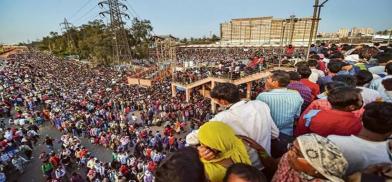India could be staring at a human security catastrophe
India has about 450 million workers in the informal sector and about a third of them are in the migrant cluster. Even if it is estimated that half of this workforce is grappling with hunger, the numbers are mind-boggling, writes C Uday Bhaskar for South Asia Monitor

Reviewing the massive disruption that the 21-day COVID-19 national clampdown has had on India’s economy and as to when this may be lifted, a senior government official provided a useful ready-reckoner in relation to national GDP. It was indicated that a back of the envelope calculation showed India's daily GDP to be roughly $8 billion (Rs. 60,000 crores) and that "a 30-day lockdown can approximately lead to a loss of little over $250 billion. If the lockdown is eased and lifted soon, the economy can recover some lost ground in financial year 2020-21. A long lockdown will push things beyond recovery." For the record, the financial year began on April 1.
This is a major national macroeconomic concern and has many domain experts working on policy options for the political leadership to review and make the appropriate choice. However, it is not evident that a similar exercise has been conducted or is in the pipeline when it comes to the loss of human lives due to the COVID-19 clampdown.
There is no single point of reference or governmental responsibility when it comes to the vast demography of India that lives in dire poverty and this is the spectrum that has been most affected by the 21-day clampdown. However, two weeks after the clampdown that began on March 25, the images and reports that have surfaced are heart-rending and testify to the deteriorating human security index of those displaced or rendered jobless by the clampdown.
Pictures of such vulnerable citizens walking back to their homes in rural India – often carrying children or the aged on their shoulders - are reminiscent of visuals associated with famine and pestilence. The most vulnerable had no recourse to basic survival options. The state was floundering to cope with the scale of what had erupted and this is an exigency that Delhi must avoid at all costs in the months ahead. GDP growth, even if adversely affected, can be recovered over a longer period of time but a human life lost to hunger is irreversible and a cynical reflection on the priority accorded to human security by more privileged and empowered India.
Poverty is endemic in India and successive governments have sought to redress this gross socio-economic inequity with varying degrees of success. But for now, the reports trickling in from different parts of India and a few data-based assessments are illustrative of the scale and texture of the hunger challenge. However, the silver lining is that swift policy action by Delhi can help to mitigate the threat to life that can otherwise escalate. leading to an exigency wherein the deaths due to hunger can outstrip those which will be saved by the COVID-19 clampdown.
PARI (Peoples Archive Rural India), an NGO founded by P Sainath, one of India’s most respected chroniclers of the poor, has shed much-needed light on the plight of those displaced or rendered jobless due to the clampdown. In a recent report, the tribals of Palghar district outside of Mumbai and their tragic condition was detailed. A mother had no food for her children for the sole bread-winner, a daily wager, was jobless since end March. Regrettably, this spread of hunger across the country is the proverbial tip of an iceberg that does not make it to the ‘breaking news’ cacophony that dominates Indian audio-visual media with shrill and repetitive outbursts of abusive heat and dust.
The truth is that 90 km outside of Mumbai, the financial capital and home to most of India's billionaires, one cross-section of citizens is likely to soon die of hunger. Hunger that can be alleviated, if the elite across the board had more compassion and empathy for the less fortunate among a teeming 1.3 billion citizenry. The cruel irony is that as of March this year, the national granary was overflowing with about 78 million tonnes of food grains, comprising 27.5 million tonnes of wheat and 50.2 million tonnes of rice.
Number crunching is a more reliable guide to estimate the contour of the hunger iceberg and Jan Sahas, a civil society group that focuses on human rights and excluded communities, has conducted a rapid assessment of migrant workers across northern and central India affected by the clampdown. A total of 3196 workers were surveyed over a three day period (March 27–29) and it was estimated that 92.5 percent labourers have already lost one to three weeks of work. Furthermore, the study concluded that 80 percent of India’s migrant and daily wage population fear they will run out of food before the end of the 21-day period on April 14.
India has about 450 million workers in the informal sector and about a third of them are in the migrant cluster. Even if it is estimated that half of this workforce is grappling with hunger, the numbers are mind-boggling.
The CCS (Cabinet Committee on Security) must deliberate TODAY on how to avert this human security catastrophe and immediately authorise the release of rice stocks held by the Food Corporation of India to state governments for setting up free food kitchens for the most needy and the disbursal of grains through traditional distribution where applicable. Experts have estimated that for 10 million (one crore) individuals for 21 days, the state needs to provide just about 75,000 tonnes of rice.
The delay of even one day can make the difference between life and death. Ask the Adivasi mother in Palghar – if she and her family have not succumbed to hunger already.
(The writer is Director, Society for Policy Studies. He can be contacted at cudaybhaskar@spsindia.in)









Post a Comment